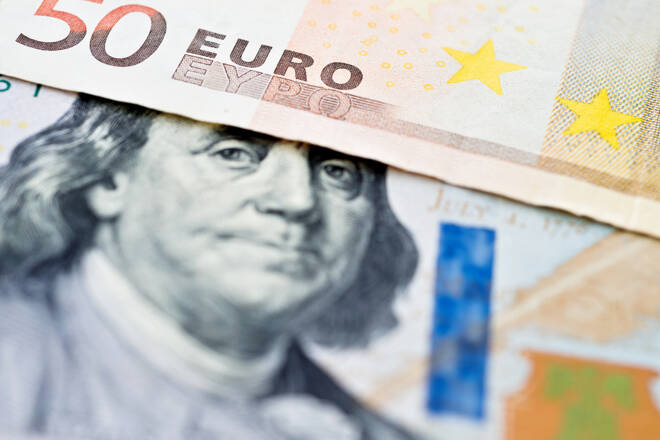Advertisement
Advertisement
EUR/USD Weekly Forecast: US CPI Numbers, the Fed, and the ECB in the Spotlight
By:
The near-term fate of EUR/USD hangs in the balance as the US CPI Report, Fed, and ECB decisions loom large. Interest rate trajectories and private sector PMIs will shape the currency pair's outlook.
Highlights
- US inflation numbers and the Fed will dictate trends in the first half of the week.
- On Thursday, the ECB press conference will be a focal point.
- Preliminary private sector PMIs will wrap up a pivotal week for the EUR/USD.
Weekly Overview of the EUR/USD in the Week Ending December 8, 2023
In the week ending on December 8, the EUR/USD declined 1.10%, closing the week at $1.07588. The EUR/USD rose to a Monday high of $1.08949 before falling to a Friday low of $1.07238.
EUR/USD Analysis: Key Drivers and the ECB
On Tuesday, ZEW Economic Sentiment data for Germany and the Eurozone will impact EUR/USD. Mixed recent economic indicators add significance to this report. German factory orders, industrial production, and trade data contrasted with positive survey-based data.
Eurozone industrial production (Wed) matters ahead of the ECB monetary policy decision (Thurs). Weak macroeconomic conditions and softer euro area inflation boost expectations of an ECB rate cut in H1 2024. Forward guidance on inflation, the economy, and interest rates will be crucial, placing greater emphasis on the ECB press conference.
Friday puts inflation, December private sector PMIs, Eurozone wage growth, and trade data into focus. Inflation, Services PMIs, and wage growth could influence EUR/USD buyer sentiment.
The services sector is the driving force behind inflation. Sticky inflation, a pickup in service sector activity, and higher wages could delay ECB rate cut discussions. Wage growth fuels consumer spending and demand-driven inflation, requiring a more hawkish ECB rate path.
US Dollar Update: Inflation, the Fed, and Services PMI
Consumer price inflation data (Tues) starts the week for the US dollar. Following the surprise Jobs Report, persistent inflation might delay Fed rate cut talks.
On Wednesday, producer price figures also matter. An uptick in producer prices could indicate rising demand and consumer price inflationary pressures. Higher demand allows producers to pass rising costs onto consumers.
The Inflation and US Jobs Reports will impact the Fed’s rate path. Wednesday brings the Fed’s rate decision, statement, economic projections, and press conference. Forward guidance on a Fed rate cut’s timing will be significant. Fed Chair Powell may surprise markets by discussing a potential rate hike.
Thursday brings retail sales and jobless claims into focus. Increased consumer spending could fuel demand-related inflation, prompting the Fed to stick to a hawkish rate path. A more hawkish rate path impacts borrowing costs, reducing disposable income. Downward trends in disposable income could affect consumer spending and dampen demand-driven inflationary pressures.
On Friday, preliminary December private sector PMIs, industrial production, and NY Empire State Manufacturing data need consideration. The Services PMI on Friday carries significant influence, as it drives inflation, accounting for over 70% of the US economy.
Short-Term Forecast:
Near-term EUR/USD trends will hinge on the US CPI Report and the Fed and ECB policy decisions. Forward guidance on the respective interest rate trajectories could be pivotal before the private sector PMIs on Friday.
EUR/USD Price Action
Daily Chart
The EUR/USD sat below the 50-day EMA while holding above the 200-day EMA, sending bearish near-term but bullish longer-term price signals.
A EUR/USD break above the 50-day EMA would support a breakout from the $1.07838 resistance level. A EUR/USD move through the $1.07838 resistance level would bring the $1.09294 resistance level into play.
The US CPI Report, the FED, the ECB, and private sector PMIs will be focal points.
A fall through the 200-day EMA would bring the $1.06342 support level into play. A dovish ECB and hawkish Fed would impact buyer demand for the EUR/USD.
The 14-period Daily RSI at 44.72 suggests a EUR/USD fall to $1.07000 before entering oversold territory.
4-Hour Chart
The EUR/USD held below the 50-day and 200-day EMAs, sending bearish price signals.
A EUR/USD break above the $1.07838 resistance level and the 200-day EMA would bring the 50-day EMA into play. A breakout from the 50-day EMA would give the bulls a run at the $1.09294 resistance level.
However, a fall through the $1.07000 handle would support a drop to the $1.06342 support level.
The 14-period 4-Hourly RSI at 36.09 suggests a EUR/USD fall to $1.07000 before entering oversold territory.
About the Author
Bob Masonauthor
With over 28 years of experience in the financial industry, Bob has worked with various global rating agencies and multinational banks. Currently he is covering currencies, commodities, alternative asset classes and global equities, focusing mostly on European and Asian markets.
Advertisement
